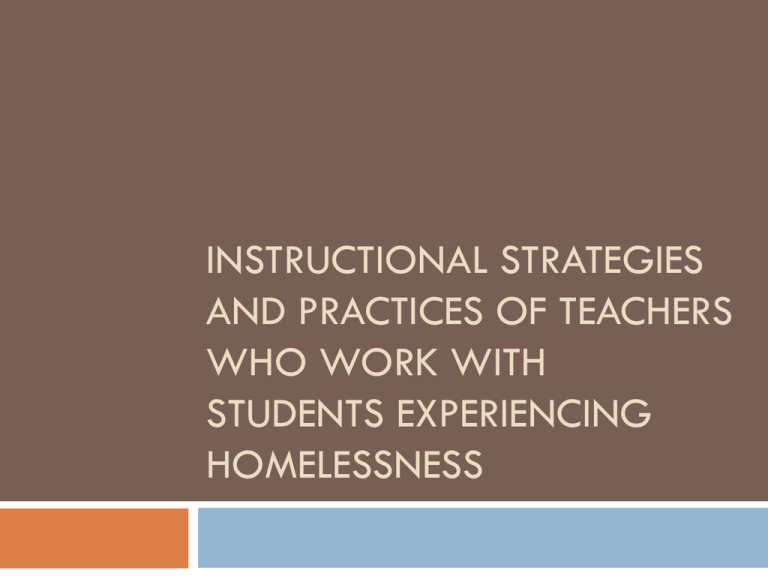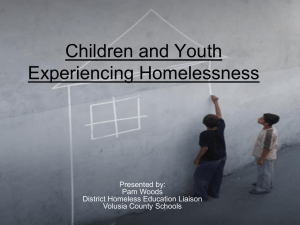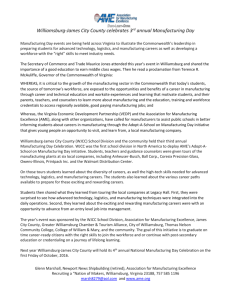Instructional Strategies and practices of teachers who work with
advertisement

INSTRUCTIONAL STRATEGIES AND PRACTICES OF TEACHERS WHO WORK WITH STUDENTS EXPERIENCING HOMELESSNESS Presenters Kimberly Pickles, Principal WJCC Public Schools Doctoral Candidate: The College of William and Mary Stephanie Leek, School Social Worker WJCC Public Schools Objectives/Goals Participants will be exposed to the perspectives of classroom teachers regarding the challenges they face educating students experiencing homelessness •Participants will be able to identify and describe four areas related to supporting homeless students in the classroom • Objectives/Goals Continued Participants will identify ways that teachers can change their instructional process to meet the learning and emotional needs of students who are homeless •Participants will be provided with district-level strategies utilized to support school-based staff • Pedagogical Practices of Teachers of Homeless Students Qualitative Research Pilot Study •College of William & Mary, Williamsburg, VA • Purpose: To examine the pedagogical practices of teachers who have instructed homeless students. To explore the needs and strategies that teachers can use to differentiate and accommodate their instruction to maximize achievement for these students. • Research Question What are the pedagogical practices of teachers who have had students who are homeless? Specifically, once a teacher learns that s/he has a student who has been identified as a student who is currently homeless, what ways does s/he change their instructional process to meet the learning and emotional needs of the student? Research “According to state education agencies, the most frequently reported educational needs of homeless children are as follows: remediation/tutoring; school materials and clothes; support services such as counselors; after school/extended day/summer programs to provide basic needs for food and shelter and recreation; transportation; educational program continuity and stability; and sensitivity and awareness training for school personnel and students” (Rafferty, 1998, p.50) Research “Teachers of highly mobile students must develop the skills to make them feel welcome while quickly weaving them into classroom routines” (Holgersson-Shorter, 2010, p.33) 4 Steps to Support Students 1. “Heightening their awareness for the dynamics of the lives of children and families who are homeless” (Swick, 2000; Powers-Costello and Swick, 2011) 2. “Engaging in experiences that deepen their sensitivity to the contextual elements that are pervasive in being homeless” (Powers-Costello and Swick, 2008; Sleeter, 1993; Swick, 1996; Powers-Costellow and Swick, 2011) 3. “Developing an action plan that provides some cohesive direction to their work” (Powers-Costello and swick, 2011). 4. “Helping teachers become active in building relations with students, parents, colleagues, and community that promote school success” (Swick, 2000; Powers-Costello and Swick, 2011). Method Collective ethnographic case studies Research Design of advocacy/participatory research Group of individuals that are faced with the social issues of the day and in which an action agenda for reform within the schools would change the lives of the homeless children in the classroom. Critical Theory Examines the changes and interactions related to the improvement of the educational impact of students who experience homelessness Participants Three Elementary School Teachers 5th grade reading teacher “Jane” 25+ 5th grade math teacher “Mary” 10 1st years teaching experience grade teacher (all subjects) “Helen” 8 years teaching experience years teaching experience Suburban School District Participants Participants have worked with a student or students that have experienced homelessness while in their classrooms Living in a women’s shelter with mother and within the zone of the shelter Doubled up with friends and then moved to hotel (in zone and then out of zone) Started in a home, doubled up out of city and stayed school of origin Interviews Structured Interview Questions; Open Ended Face to face Focused on identifying the pedagogical practices of teachers who instruct homeless students Focused on how they adjusted their instruction for students experiencing homelessness Recommendations to improved academic success Findings Four categories/themes Choices made by the parent to be able to provide for their child(ren) or the lack of the choices that they have available Perceptions of the classroom teacher Relationship development between the teacher and the child and the teacher and the parent for positive learning experience Available/recommended supports within the school and classroom Findings Con’t Choices Lack of ability to make choices “Parents don’t normally come and that is just either because they are working during the day and they don’t have a means to get to the school or they are at home taking care of the other kids. I do make sure that I am sending home weekly communication and would say that some are good about communicating back and some are not. I would like to think sometimes they have bigger things to worry about.” -“Mary” Findings Con’t Choices Home support is key “I think that home support is a key thing and that you see that the parents are just struggling to get by. It could be the parents had no choice or the parents just aren’t giving the kids the attention.” – “Jane” Don’t hold parent’s choices against the child “Parents of homeless kids seem to focus more on their own problems which is probably understandable and the kids seem to fall to the wayside because school’s important, but not that important” – “Jane” Findings Con’t Choices Be aware many parents have made difficult choices and are doing the best they can so their children have a good educational opportunity “I don’t necessarily think that the parents intend to not be supportive, it’s just that they are so busy with everything else they have, whether it is just trying to find a job or trying to find a home or trying to be the parent, that sometimes school just comes last.” – “Helen” Findings Con’t Perceptions Preconceived ideas may present the opposite “He was very bright, which surprised me, because I thought, you know, a lot of times you want to think that they are not academically there. But he was also very bright. His big thing for me was that he was very worldly.” –”Mary” Keep in mind the child may be embarrassed by their situation and may not have an opportunity to act like a kid. Be open minded and not let stereotypes guide their idea of a homeless child. Findings Con’t Relationship Development Promote a positive learning experience for the child Put in the time necessary to develop a relationship Take the time, build the relationship, develop the trust and understanding for the student and family Findings Con’t Relationship Development “I like it to be a trusting place where kids can come to feel safe… kids come in and other children need to accept children for who they are and where they are as far as learning. You know a lot of these kids come from situations where this is their only safe place to be and you don’t know what they are going home to, so I want them to feel secure and safe.” – “Jane” Findings Con’t Supports Extra instructional materials Services for remediation/extra hour or two of consistency Free Breakfast and Lunch programs Field trips to support learning culturally Outreach programs invited into the school Human need items (clothes, coats, food) Counseling and health supports In-services for educators Conclusions These children have many needs beyond a typical student •Teachers need to be aware of background circumstances and knowledge of the difficulties and choices the family is facing •Need to be aware of their preconceived perceptions; Have an open mind •Treat each situation individually • Conclusions Develop relationships, build trust, safety, and security within the classroom •Additional supports are always needed • Williamsburg – James City County Demographics City of Williamsburg Population: 14, 068 20.3% living below the poverty level 14.5% unemployment James City County Population: 67,009 7% living below the poverty level 7% unemployment Available Resources Avalon Shelter Transitional housing program Faith Based Community Supports the United Way Community Resource Center GWOM Shelter program WJCC Public Schools Population: 11,030 (2011-2012) 15 schools – 9 Elementary, 3 middle, 3 High Homeless identification trends: 2005/2006 – 86 2006/2007 – 109 2007/2008 – 223 2008/2009 – 106 2009/2010 – 217 2010/2011 – 353 2011/2012 - 428 Available Resources Project HOPE School Social Work staff Erase the Needs Center Division Wide Interventions Awareness and Education program Training program for all school staff/employees Strategies appropriate to the group, i.e. teachers, administrators, registrars, bus drivers, custodians Resource and Guidance manual – Connecting the Pieces: Access, Stability, Success Outreach materials specific to school division Division Wide Interventions, Con’t Homeless Education Coordinator Case management services for high risk preschool students and families Needs assessment of preschool staff - results provided to staff and used to guide activities Available for onsite consultation for staff and administration Provide continued training on M-V and strategies for classrooms and interacting with families Link with school age programs Stonehouse Elementary School Located in James City County Population: 652 26.84% free or reduced lunch 21.01% free 5.83% reduced Stonehouse Interventions School Social Worker providing trainings and sharing with teachers Transportation vouchers provided by the PTA SCA members volunteering in the community Sea Star Power Pack program Staff donations Interactions with different community groups and individuals Raising awareness with local churches, organizations, Boy/Girl Scouts, and within the school A meaningful way for students to help Thank You Kim Pickles Principal, Stonehouse Elementary School WJCC Public Schools picklesk@wjcc.k12.va.us 757-566-4300 Stephanie Leek School Social Worker WJCC Public Schools leeks@wjcc.k12.va.us 757-634-9325









